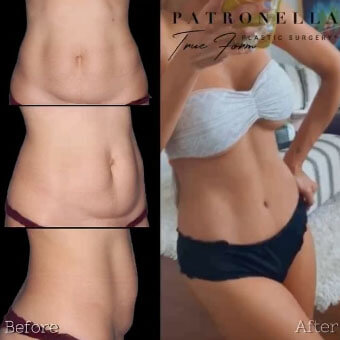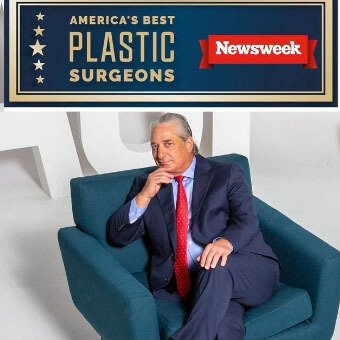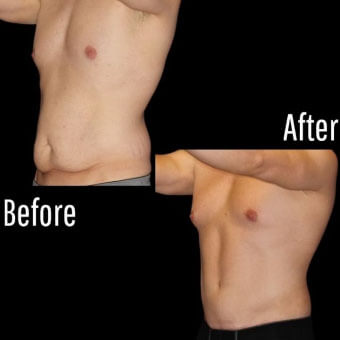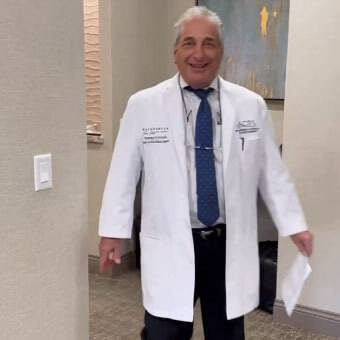Solutions To Prevent Breast Augmentation Complications
Posted June 17, 2015 in Breast Augmentation, Breast Revision
By Dr. Chris Patronella
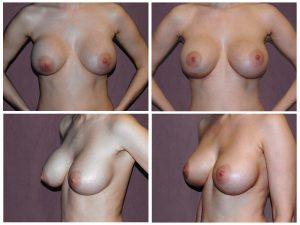
Through corrective-revision breast implant surgery, Dr. Patronella restored a more symmetrical, natural-looking shape to this patient’s breasts. Dr. Patronella removed scar tissue and replaced this patient’s above-the-muscle breast implants with implants that he positioned beneath the pectoral muscle.
Every single breast augmentation patient forms a capsule around a scar. This is the body’s normal immune response to any foreign device that’s placed inside the body such as a Pacemaker—its way of protecting the body from what it detects to be an unnatural invader. However, in some patients, this normal immune response is excessive, and the scar tissue tightens. One of the most common issues I correct through breast revision surgery is capsular contracture, a complication that occurs when scar tissue tightens too much around the breast implant(s) after breast augmentation surgery. The outward symptoms can be subtle or noticeable depending upon the severity of the condition. Most commonly it can distort the shape of the affected breast(s) and cause it to feel hardened.
In my own experience, I’ve identified two measures that greatly decrease the likelihood of capsular contracture occurring among my breast augmentation patients:
- Ensure that the space created for the breast implant during the breast augmentation procedure is large enough for the implant.
- Implement exercises in which the patient physically massages the breast to move the implant around the pocket that is created for it during surgery.
By manually moving the implant via massage in the early period after surgery, the tendency of the scar’s collagen fibers to interlock and tighten around the implant is reduced. It’s like physical therapy on a joint: physical therapists try to stretch out the scar fibers on a joint that’s been operated on so that the scar fibers are no longer tight. It’s important to begin stretching the scars in the early stages of their development in order to regain joint mobility.
With implant displacement exercises, we’re trying to fool the body into believing the breast implant is bigger than it is by moving it upward and downward through massage, thereby reducing the likelihood of scar tissue tightening around the implant. The key is to do this early, frequently, and diligently.
For more than 15 years, my staff and I have provided my breast augmentation patients with careful instruction for implant displacement exercises. Since incorporating this into patients’ postoperative routine, I rarely see a capsular contracture case among them, with a less than 5% incidence of it occurring in the past 23 years I’ve performed surgery.
In spite of this measure, a small percentage of patients still will develop capsular contracture. Plastic surgeons hold differing opinions regarding the causes. Some believe it’s caused by the presence of small numbers of bacteria and/or blood around an implant that incites a more dramatic scar tissue response. In these cases, patients may experience a very low-grade non-symptomatic infection. To help prevent this, I incorporate irrigation of the implant and breast pocket with an antibiotic solution, and I prescribe oral antibiotics for the patient, as well.
The combination of these measures has proven to be a highly effective formula to reduce one of the most common complications of this popular procedure, helping to ensure my patients can enjoy the aesthetic and confidence-boosting benefits of long-lasting, soft and shapely breast augmentation results.
Are you interested in learning more about breast revision surgery to improve the results you received from a previous breast surgery procedure? Contact us at (713) 575-1996 to schedule your consultation with Dr. Patronella.


